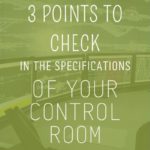
The security sector (army, defence, police, etc.) has a particularity in the world of control spaces: the supervision/monitoring room is almost always coupled with a command/pilot room. It should be noted, however, that this may be the case for other sectors of activity (process industries, information systems, transport, etc.) but it is less frequent.
The distribution of equipment, a consequence of the division of labour
Let’s look for a moment at what makes the functional difference between these two spaces. Basically, the surveillance space is there to provide the most relevant data possible to the command room. In the command room, on the other hand, the equipment is there to support decision-making, but not only: in addition to directing operations, there is often an intense communication activity: reporting, informing the press or third parties, exchanging with distant specialists, etc. Finally, the command room is the place where the scenarios prepared prior to the crisis or operations in an analysis and preparation room are used. It should be noted in passing that these analysis rooms can also be used in real time to provide the command room with enhanced information.
In the end, this division of tasks between the two rooms makes it possible to separate the “red” zone = the command/pilot room where the pressure is maximum, the exchanges are lively, and there are regular comings and goings – and the “blue” zone = the supervision/monitoring room where the operators must remain concentrated in a calm environment on acquiring data as well as on the coherent and controlled transmission of this information to the control room. Mixing the two areas is never desirable but at the same time communication between the two areas must be maintained.
The translation of the above into equipment is both in terms of the layout and the nature of the solutions deployed.
As far as the layout of the supervision area is concerned, everything must be based on the ergonomic display of information. In concrete terms, thought must be given to the distribution of displays between the screens on the operator consoles and the video wall: which sources are to be displayed on one medium or the other, and which ones are to go back and forth between the two? Finally, the layout of the video wall must allow for a view without moving from all the consoles.
The layout of the command / control room
…must be more focused on collective decision-making tools; it is often a large touch screen that will play this role, either in vertical form or as a touch table. The displays are then organised around it, if possible in a modular manner. Indeed, security professionals know from experience that one should not blindly rely on the crisis scenarios envisaged at the outset. For this reason, we recommend a reconfigurable space around this touch screen.
Finally, as mentioned above, communication between the two locations is essential. On the audio side, this can be done via a dedicated IP line, while on the video side, two different ways can be used to meet the need:
- a videoconference-type connection, or even better, a videocollaboration tool that will allow real-time work on common documents
- a large glass surface between the two rooms, which can be darkened on demand (Privalite type glass) by a simple switch.
In terms of the nature of the solutions deployed, the operators in the monitoring space must quickly access the sources made available to them and display them on their screens and the video wall according to predefined or on-the-fly display scenarios. In concrete terms, all the necessary tools are described at length in our Control and Monitoring Room Guide: video wall, video server, operator consoles, 24/7 seats, KVM, etc.
Sensors (fixed cameras, drones, alarms, …) are coupled with information from the field or from external media (internet, social networks, continuous TV channels, …)
For the command and control room, business software (cartography, big data, etc.) is superimposed on a selection of data/images provided by the surveillance area. The solutions deployed are more interactive than in the surveillance space: touch table, TBI software, video, etc. What does not change, however, is displaying the right information in the right place.
In conclusion, we can say that the complementarity of the two spaces must be thought through from the start, particularly in the management of key sources that are intended to be displayed on both sides. Furthermore, on a practical level, we strongly recommend using the same control software on both sides, the interoperability of the two spaces being at the heart of the success of such an investment.
Do you want to implement or optimise a control room?
Download our free guide:








